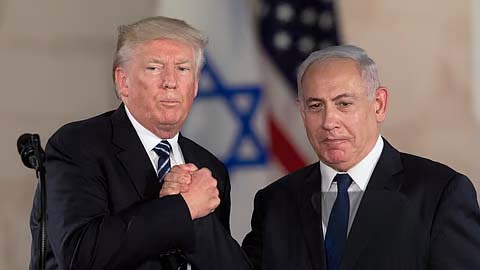WADI GAZA, Jan 29: President Donald Trump has extended an invitation to Israeli Prime Minister Benjamin Netanyahu to visit the White House next week, marking Netanyahu as the first foreign leader to meet with Trump in his second term, as confirmed by both Netanyahu and the White House on Tuesday.
This announcement comes as the United States continues to push Israel and Hamas to uphold a ceasefire that has brought a halt to a devastating 15-month conflict in Gaza. Discussions regarding the more challenging second phase of the ceasefire, which aims to bring an end to the war, are set to commence next Monday.
A letter from the White House, shared by Netanyahu’s office on Tuesday, expressed, “I look forward to discussing how we can foster peace between Israel and its neighbors, along with efforts to address our shared adversaries.”
The meeting on February 4 presents Netanyahu, who faces domestic pressures, with an opportunity to showcase the longstanding support he has received from Trump and to defend Israel’s military actions during the conflict. Last year, the two leaders met in person for the first time in nearly four years at Trump’s Mar-a-Lago estate in Florida.
As the largest recipient of U.S. military aid, Israel will likely see Netanyahu urge Trump to expedite weapon deliveries, which had been delayed by the Biden administration, although some military support continued.
Netanyahu is also expected to encourage Trump to exert greater pressure on Iran and revive efforts to facilitate a historic normalization agreement between Israel and Saudi Arabia, a key rival of Iran and the foremost power in the Arab world.
Even before officially taking office, Trump dispatched his special Middle East envoy, Steve Witkoff, to the region to help ensure the establishment of the current Gaza ceasefire, in collaboration with the Biden administration.
However, Netanyahu has pledged to resume military action if Hamas fails to comply with his stipulations during negotiations regarding the second phase of the ceasefire, which aims to achieve a complete Israeli withdrawal from Gaza and establish a “sustainable calm.”
Over 375,000 Return to Northern Gaza
According to the United Nations, more than 375,000 Palestinians have made their way back to northern Gaza since Israel permitted their return on Monday morning. This figure accounts for over a third of the one million people who fled during the initial days of the war.
As many Palestinians traversed a coastal road or traveled by vehicle after undergoing security checks, they observed the extensive destruction in northern Gaza as the fragile ceasefire enters its second week.
This week, Trump proposed that Egypt and Jordan temporarily accept Palestinians from Gaza, suggesting, “we just clean out that whole thing,” a notion quickly rebuffed by Egypt, Jordan, and the Palestinians, who feared that Israel would not allow for a return.
Determined to return, many Palestinians are now setting up makeshift shelters or sleeping outdoors among the rubble and precariously leaning structures. After enduring months of poor living conditions in overcrowded tent camps or makeshift schools in southern Gaza, they are eager to return to their homeland.
“It’s still better for us to be on our land than to live on land that isn’t ours,” expressed Fayza al-Nahal, as she prepared to leave the southern city of Khan Younis for northern Gaza.
At least two Palestinians attempted to reach the north by sea, cramming themselves into a small boat alongside a bicycle and other belongings.
Hani Al-Shanti, displaced from Gaza City, expressed his desire for peace in whatever he finds, stating, “even if it is just a roof and walls without furniture, or even if it is without a roof.” One woman, newly returned, hung clothes amidst the ruins of her destroyed home.
Next Steps
As part of the ceasefire agreement, a new round of hostage exchanges is set to take place this Thursday, followed by another transfer on Saturday. During the first six-week phase of the ceasefire, a total of 33 hostages taken during the Hamas-led assault on October 7, 2023, which initiated the war, are expected to be released, alongside nearly 2,000 Palestinian prisoners.
This week, Israeli officials announced that a list provided by Hamas confirmed the tragic news that eight of the 33 hostages to be released are deceased, causing renewed anguish for Israeli families who have long urged the government to finalize an agreement for the safe return of all hostages before it’s too late.
On Tuesday, one of the first hostages to be released under the current ceasefire – the second overall in the conflict – offered a glimpse into her experience in captivity. Naama Levy, 20, shared via social media that she spent the majority of the first 50 days alone before reuniting with other soldiers kidnapped from her military base on October 7, as well as other civilian captives.
“We supported each other until the day of our release, and even afterwards,” she stated.
Aid Continues to Flow
A significant increase in humanitarian assistance entering Gaza has persisted under the ceasefire. “In just the past week, around 4,200 trucks carrying aid have been allowed into the Gaza Strip after inspections,” announced Israel’s Deputy Foreign Minister Sharren Haskel. The agreement stipulates that 600 trucks of aid are to be admitted each day.
The government of Qatar, serving as a mediator in the ceasefire negotiations, reported on Tuesday that while there have been complaints from both parties, no confirmed violations of the ceasefire have occurred that could jeopardize the agreement.
This ceasefire aims to bring to a close one of the deadliest and most destructive conflicts seen between Israel and Hamas in history. Militants killed around 1,200 individuals, predominantly civilians, during the October 7 attack and subsequently abducted approximately 250 people.
In retaliation, Israel launched an extensive air and ground offensive that has resulted in the deaths of over 47,000 Palestinians, more than half of whom are women and children, according to Gaza’s Health Ministry. The ministry does not specify the number of combatants among the dead, while Israel claims to have killed over 17,000 militants, although no evidence has been presented. (AP)


Leave a Reply